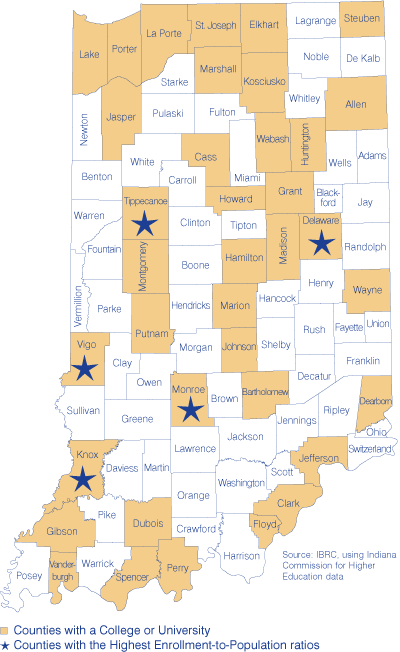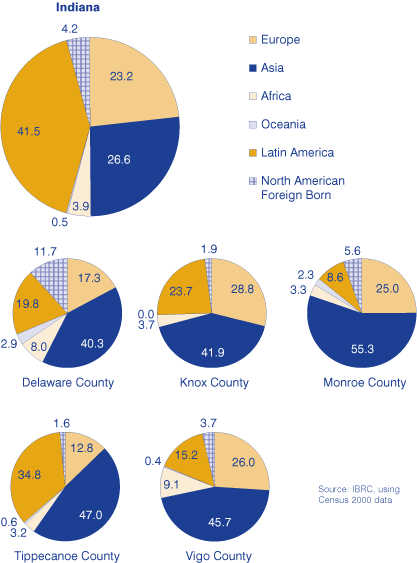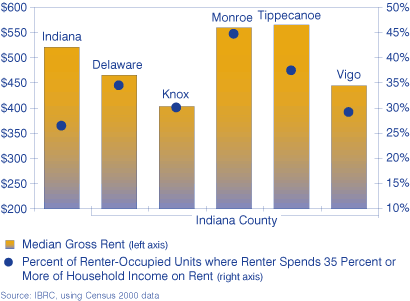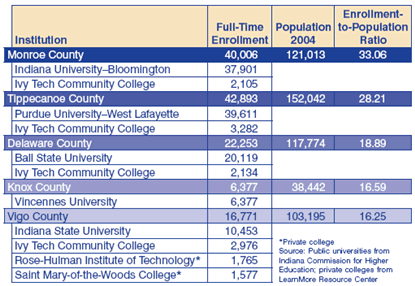A Closer Look at Indiana's College Counties
Mention Bloomington, Indiana, and what's the first thing that pops into your head? More likely than not, it will have something to do with Indiana University. West Lafayette? Why, Purdue, of course.
As students flock back to these quintessential college towns to begin the spring semester, we will examine a handful of Indiana's university communities and the demographic and economic characteristics that set college towns apart nationwide. (1)
While 37 of Indiana's 92 counties possess at least one higher education institution (see Figure 1), the university shapes the regional character in only some. A quick way to quantify a college's influence is to look at the ratio between enrollment and population. For example, over 30 percent of Monroe County's population is enrolled at IU (see Table 1). This article focuses on Monroe, Tippecanoe, Delaware, Knox and Vigo counties, which have the five highest enrollment-to-population ratios statewide.
Figure 1: Indiana's College Counties

Table 1: Enrollment to Population Ratios by County
Demographic Characteristics
One doesn't need a college degree to realize that places with a university will have a younger population. More than 20 percent of Monroe County's population is between the ages of 18 and 24 (twice the state proportion), according to 2004 population estimates. Thus, the median age is 28.9 years old, or about 7 years younger than the Indiana median. However, Tippecanoe is the youngest county in the state, with a median age of 28.1 years. Knox County is the only one of the five whose median age (37.7 years) exceeds the state average.
Well Educated
In Indiana, 19 percent of those age 25 and older have a bachelor's degree or higher; nationwide, the figure raises to 24 percent, according to Census 2000. Over 25,000 people in both Monroe and Tippecanoe counties have a bachelor's degree or higher, which equates to 40 percent and 33 percent of the populations, respectively. Vigo and Delaware counties both top 20 percent. Knox County falls below the others (14 percent), primarily because Vincennes University is a two-year institution, so a disproportionate chunk of the Knox County population (11 percent) hold associate's degrees.
Diverse
Together with some of the larger metro areas, these counties are more diverse than other areas of the state, with particularly large concentrations of Asians (includes only those classifying their race as Asian alone). For example, Monroe and Tippecanoe counties account for 4.4 percent of the total Indiana population, according to 2004 estimates; however, with nearly 13,000 Asian residents, they account for almost 18 percent of the state's Asian population.
Throughout the state, roughly one out of 100 people are Asian. Tippecanoe, Monroe and Vigo counties all exceed that ratio, with Tippecanoe (5.2 percent) and Monroe (4.2 percent) ranking first and second among all Indiana counties. The sheer number of Asians in Tippecanoe County (7,842) ranks third in the state on a numeric basis (behind Marion and Hamilton counties), and is a far cry from the mere three Asians living in neighboring Carroll County (ranked last).
Purdue University and Indiana University, in particular, draw students and faculty internationally. Census 2000 tells us that 8.2 percent of the Tippecanoe population and 5.4 percent of the Monroe County population are foreign-born. Only 20 percent of Tippecanoe's foreign-born population are naturalized citizens; that number is 27.2 percent in Monroe County, indicating that international students and faculty are perhaps more likely to stick around Bloomington than they are West Lafayette. However, all five college counties have lower percentages of naturalized citizens with respect to the foreign-born population than Indiana as a whole.
Where in the world are these international migrants coming from? Asia, mostly (see Figure 2). All five counties have a much higher proportion of Asians and a significantly smaller proportion of Latin American natives as compared to the state.
Figure 2: Origin of the Foreign-Born Population in Indiana and Select College Counties

On the Move
One researcher described students and professors as “relative gypsies” due to the frequency of their relocations. Census 2000 looked at where people lived in 2000 compared to where they lived five years earlier. Nearly 15 percent of the Monroe County population age 5 and older lived in a different state in 1995; that figure was about 13 percent for Tippecanoe County. In comparison, Indiana came in at 8 percent. Moreover, the percentage of the population 5 and over who lived in Indiana, but in a different county five years earlier was 19 percent in Tippecanoe County, approached 21 percent in Monroe County, and was just over 10 percent for Indiana as a whole. While these two counties have the most transient populations, all five college counties in this analysis exceed (or equal, in the case of Knox County) the state average in the total proportion of its population who lived in a different county or state in 1995 as compared to 2000.
On Their Feet
College counties heavily utilize alternate transportation, according to Census 2000. For example, in Monroe County, 8.6 percent of workers age 16 and older walk to work, which ranks first among the 92 counties and far exceeds Indiana's 2.4 percent. Meanwhile, another 1.8 percent take public transportation, which is roughly twice the state percentage. (Granted, that leaves over 50,700 people either driving alone or carpooling, but that's beside the point.)
Only 4.3 percent of Hoosiers walk, use public transportation or employ other means, such as biking, to get to their job. Monroe (12.6 percent), Tippecanoe (9.9 percent) and Delaware (6.7 percent) counties rank first, second and fourth among counties on that measure. Meanwhile, Vigo and Knox counties rank 10th and 11th at 5.3 percent and 5.1 percent, respectively.
Economic Characteristics
A certain degree of economic security comes from life in a college town since educational institutions are less likely to shut down and move away than a manufacturing plant. Using data for the first quarter of 2005, the number of people employed in the education sector ranges from over 14,000 in Tippecanoe County to nearly 2,000 in Knox County. The data for Monroe County is nondisclosable, but considering that Indiana University alone employs roughly 6,900 area residents, it is safe to say that education is one of the leading industries. Education is the second largest employer in Delaware County (behind health care) and Tippecanoe County (behind manufacturing). It is the third largest sector in Knox County and fourth in Vigo County.
Low Unemployment
College communities nationwide tend to have low unemployment rates on average, and Indiana's record is mixed. Looking at the 2004 averages, Monroe County had the lowest unemployment rate among the chosen college communities at 4.1 percent. Knox and Tippecanoe counties both had rates of 4.5 percent. However, Delaware and Vigo counties both exceeded the state rate at 6 percent and 7 percent, respectively. Over the past two years (2003:1 to 2005:1), Delaware, Knox and Vigo counties have lost job—with Delaware County's loss of over 3,200 jobs being the worst by far. Monroe and Tippecanoe counties, on the other hand, saw job increases of 4,158 and 1,124, respectively.
Rent and Group Housing
With a highly mobile population, it makes sense to have above average rental rates. Indeed, all five counties exceed the state average of 28.6 percent, according to Census 2000. Not surprisingly, Monroe and Tippecanoe counties have the most renter occupied housing as a percentage of all occupied housing (46 percent and 44 percent, respectively), while the remaining three counties are between 31 percent and 33 percent.
Median gross rent exceeds the state average in just Monroe and Tippecanoe counties, where the median rent is between $560 and $565. However, all five counties exceed the state in the percent of renter-occupied units where the gross rent is 35 percent of household income or more, and they rank first through fifth among all 92 counties on this measure. The range within the counties themselves is rather large; in Vigo County, 29 percent of its renter-occupied units have renters spending 35 percent or more of their income on rent, whereas that category encompasses 45 percent of Monroe County rentals (see Figure 3).
Figure 3: Median Cost of Rent in College Counties

Census 2000 also provides information on the number of students living
in college dormitories. This number ranges from 1,591 in Knox County to
13,288 in Tippecanoe County. Men outnumber women in dorms except in Delaware
and Monroe counties. Combined, the five counties house over 37,000 people
in dormitories, or about 29 percent of all students.
Conclusion
The perpetual rivalry between IU and Purdue is well-known to many a Hoosier. What may not be as recognized are the similarities between those two communities. While Delaware, Vigo and Knox counties exhibit the characteristics of college communities to varying degrees, it is Monroe and Tippecanoe counties, with their flagship state universities, who have the most in common.
Notes
- Blake Gumprecht, "The American College Town," Geographical
Review (January 2003): 51-80.
Rachel Justis, Managing Editor
Indiana Business Research Center, Kelley School of Business, Indiana University

